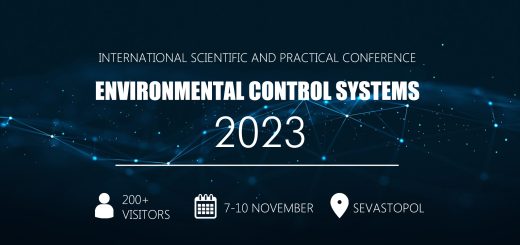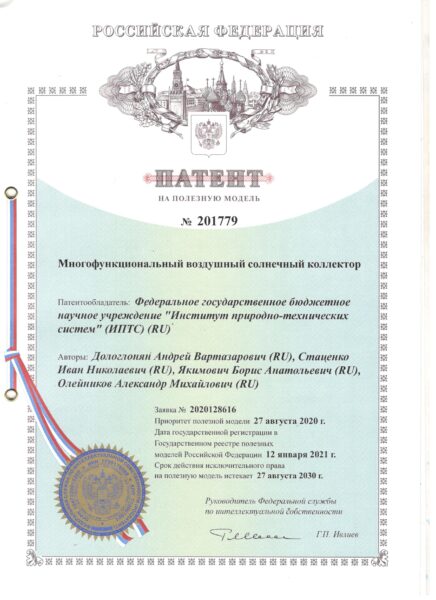
Multifunctional Air Solar collector
The multifunctional air solar collector is designed to convert solar energy into thermal energy of the air during the daytime and to cool the air and obtain fresh water at night. The essence of the utility model lies in the fact that the flat absorber is made in the form of a multilayer perforated with an increasing surface area of the absorbing panel and is horizontally mounted in the upper part of the housing facing the Sun, and the lower part of the housing is hollow and is made in the form of a truncated pyramid, the large base of which is facing the absorbing panel, and the smaller base is connected to the a liquid separator made in the form of a hollow cylinder, on one of the faces of which an air outlet channel connected to the suction cavity of the fan is made, and the lower part of the liquid separator is connected to a cup-shaped condensate collector, in the narrow part of which a branch pipe and a valve are installed, while the liquid separator, the air outlet channel and the condensate collector are formed by the walls of the collector housing. The technical result is an easy-to-manufacture and use, reliable and economical device that allows using the energy of the sun and the cold of the night sky for heat and cooling of domestic and industrial structures, as well as obtaining fresh water.
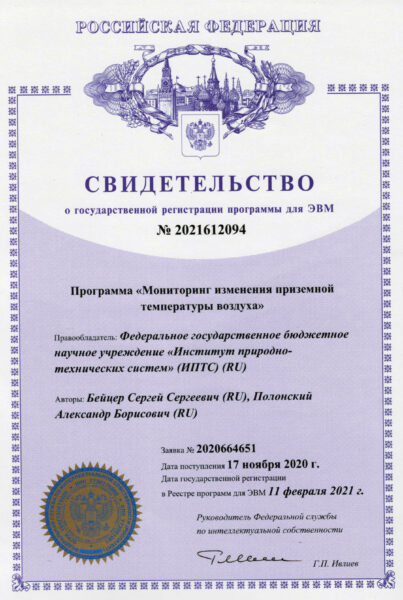
Program “Monitoring of changes in surface air temperature”
The program is designed to monitor and analyze changes in climatic parameters. The current version is designed for surface temperature according to re-analysis data. The main functions of the program: 1. Conversion of files with pe-analysis data for a specific climatic parameter (in this version – surface temperature) for the selected area [-15° ÷ 45° VD : 30° ÷ 70° SSH] and further calculations; 2. Calculation and visualization: averaged temperature values over 30 years (climate); averaged temperature values for 30 years for each month; variance of average monthly temperature values (as characteristics of the average seasonal cycle) over 30 years; variance due to the interannual variability of annual averaged temperatures over the past 30 years; linear trends of average annual temperature with an estimated confidence interval of 90 or 95%; trend difference of the time series of average annual temperatures over 30 years; variance due to interannual temperature variability for the last 30 years after the trend was removed. OS: Windows.
Programming Language: Matlab
Computer program size: 101 MB
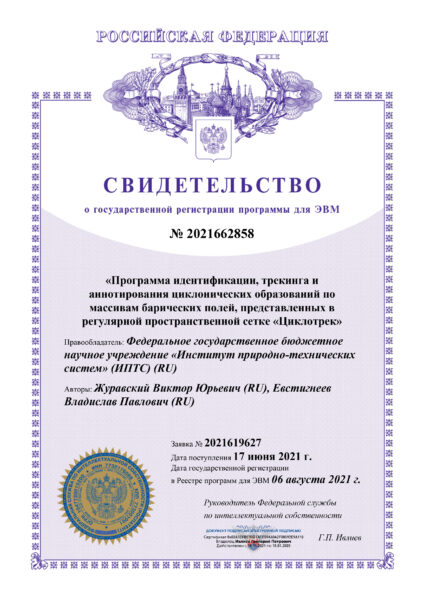
“The program of identification, tracking and annotation of cyclonic formations by arrays of baric fields represented in the regular spatial grid “Cyclotrek”
The program is designed to obtain characteristics of baric formations, such as coordinates, depth, pressure gradient, average radius, coordinates of a closed isobar according to NCEP/NCAR reanalysis data, and subsequent identification, tracking and annotation of cyclonic formations by arrays of baric fields represented in a regular spatial grid “Cyclotrek”. The results of the calculations can be used in the analysis of cyclonic activity in a given region. Main functions of the program: calculation of characteristics of baric formations; creation of a database with the characteristics of baric formations; identification, tracking and annotation of cyclonic formations by arrays of baric fields. OS: MS Windows.
Programming language: R
Computer program size: 16 KB
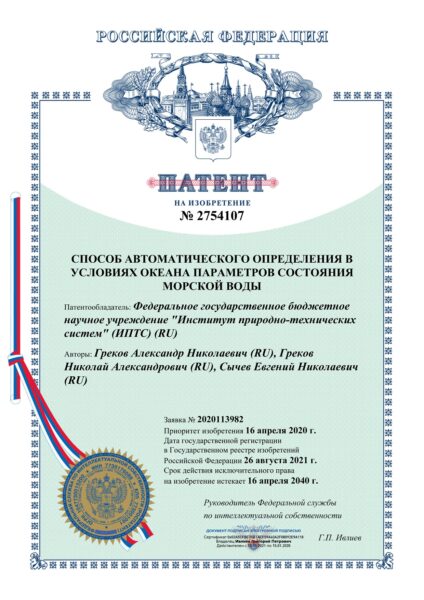
A METHOD FOR AUTOMATICALLY DETERMINING THE PARAMETERS OF THE STATE OF SEAWATER IN OCEAN CONDITIONS
The invention is intended for oceanological research and can be used in the construction of autonomous and sounding devices for determining complex hydrophysical parameters of seawater, and can also be used to control various impurities, gas bubbles, suspended solids not only in seawater, but also in river and wastewater and to study the physical properties of water, mixtures of liquids and refinement of empirical expressions in determining thermodynamic quantities and molecular properties of liquids. The essence of the invention lies in the fact that, using synchronously measured values of temperature T, pressure P, speed of sound in water c, the density p and salinity S are determined according to the developed algorithm. The measured scattering coefficients kp and attenuation kp allow us to determine the absorption coefficient kp = kp-kp and then determine the total dissipative coefficient of the enlarged image (opens in a separate window) where kp is the absorption coefficient; p is the density of seawater; c is the speed of sound in water; ƒ is the frequency of the ultrasonic signal. All measured values are determined on a stable reference base for a small volume of liquid, which makes it possible to increase the spatial, and due to synchronous measurement, the temporal resolution. The technical result is an increase in resolution with a complex determination of the parameters of the state of seawater on a quasi-real time scale. 3 table.
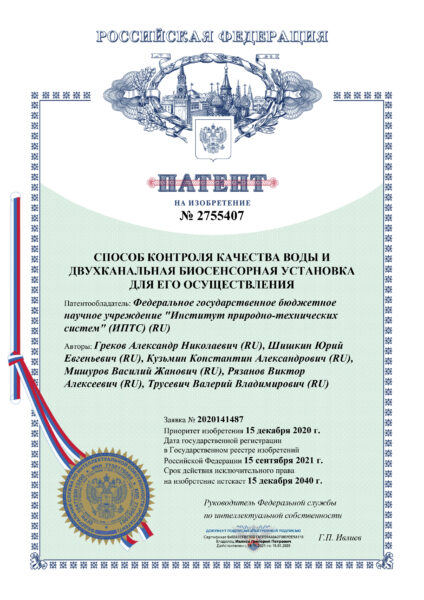
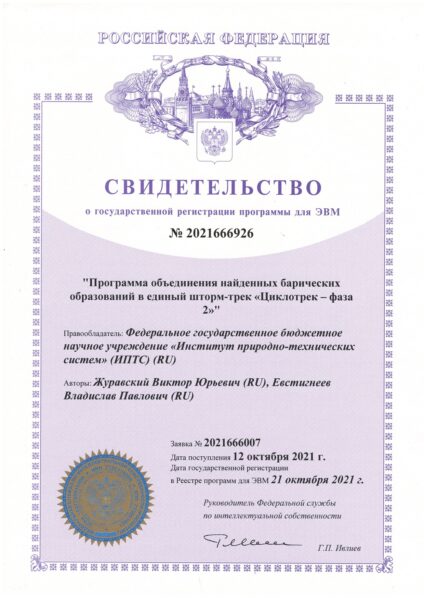
“The program for combining the found baric formations into a single storm track “Cyclotrek – phase 2″”
The program is designed to combine the found baric formations into a single storm track by NCEP/NCAR reanalysis. The calculation results can be used in the analysis of cyclonic/anticyclonic activity in a given region. The main functions of the program: the ratio of the found baric formations to a specific cyclone; creation of a database of cyclone trajectories. OS: Windows.
Programming language: R
The volume of the computer program: 3 KB

“Bioindicator parameters of the state of hydrobiocenoses of rivers of the Black Sea coast of the Caucasus (Q4 2016 – Q1 2019)”
The database is designed to store and systematize data on 12 bioindicator parameters calculated based on the analysis of the macrozoobenthos community of 7 rivers of the Black Sea coast of the Caucasus (near Sochi) at 15 stations. The database can be used to assess the hydrobiological and ecological state of natural watercourses in the specified area during the stated period, in studies of stress tolerance of aquatic organisms to extreme environmental conditions, as well as to determine the trophic potential of watercourses for the development of populations of valuable and endemic fish species. Scope of application: hydrobiology, ecology, environmental protection, nature management, education. Database functionality: input, storage and editing of information; sorting of data according to a certain criterion; plotting; processing of material using statistical methods; output of information for the construction of map layers in GIS systems.
Type and version of the database management system: Excel 2007
Database size: 344 KB
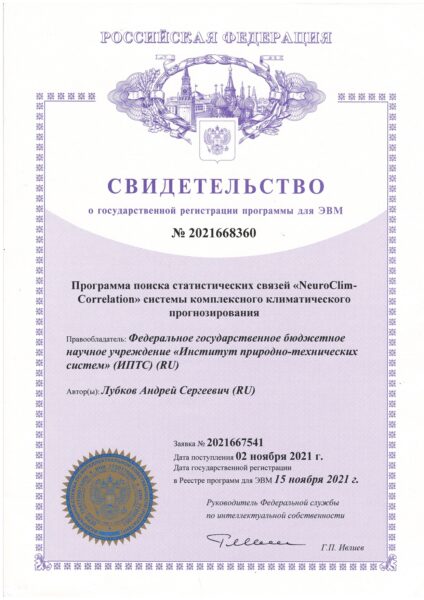
The program for finding statistical links “NeuroClim-Correlation” of the integrated climate forecasting system
The program is designed to find a statistical relationship between the interannual variability of a regional climatic parameter (for example, monthly average temperature, precipitation, bioclimatic indices) with several global climatic processes (indicators of which are usually indices of ocean-atmosphere interaction, such as the North Atlantic Oscillation, East Atlantic oscillation, El Nino – Southern oscillation, etc.) with a time shift, discreteness the step of which is equal to one month, as well as the selection of significant relationships and their subsequent ranking. The program is part of the integrated climate forecasting system based on neural networks “NeuroClim” and can be used both independently and in the system. The main functions of the program: search for significant statistical relationships; ranking of detected statistical relationships. OS: Windows.
Programming language: R
Computer program size: 10 KB
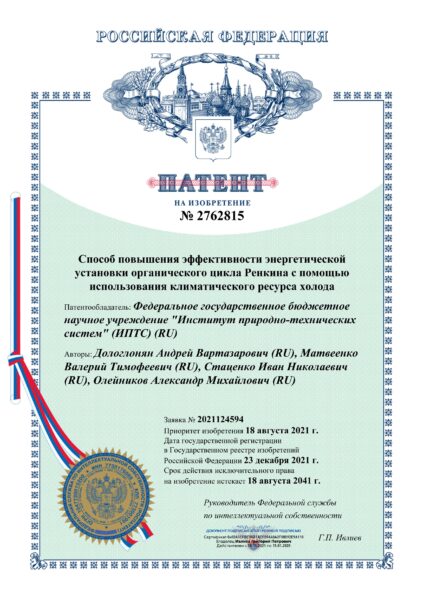
A method for increasing the efficiency of an organic Rankine cycle power plant by using a cold climate resource
The invention relates to energy, namely to methods for increasing the efficiency of installations using the organic Rankine cycle. A way to increase the efficiency of an organic Rankine cycle power plant by using a climatic cold resource is that steam coming out of the main turbine, with a sufficient decrease in ambient temperature relative to the calculated one, is directed to at least one additional turbine installed sequentially along the steam movement to the main one, which is switched on through a disconnecting coupling and performs additional work, and the exhaust steam, depending on the ambient temperature, is directed either to the next additional turbine, or into a capacitor. The technical result of the invention is an increase in the power of CRO power plants and an increase in their efficiency due to the use of a local cold resource.
